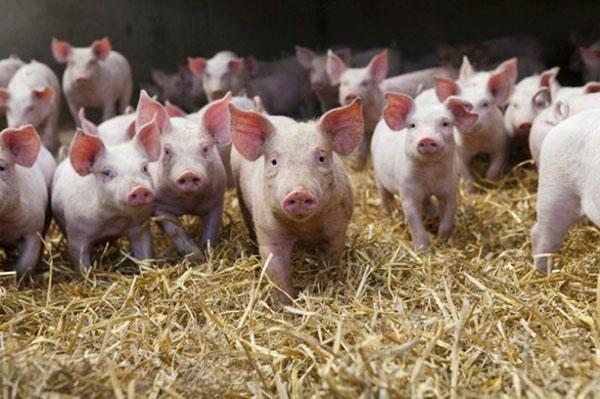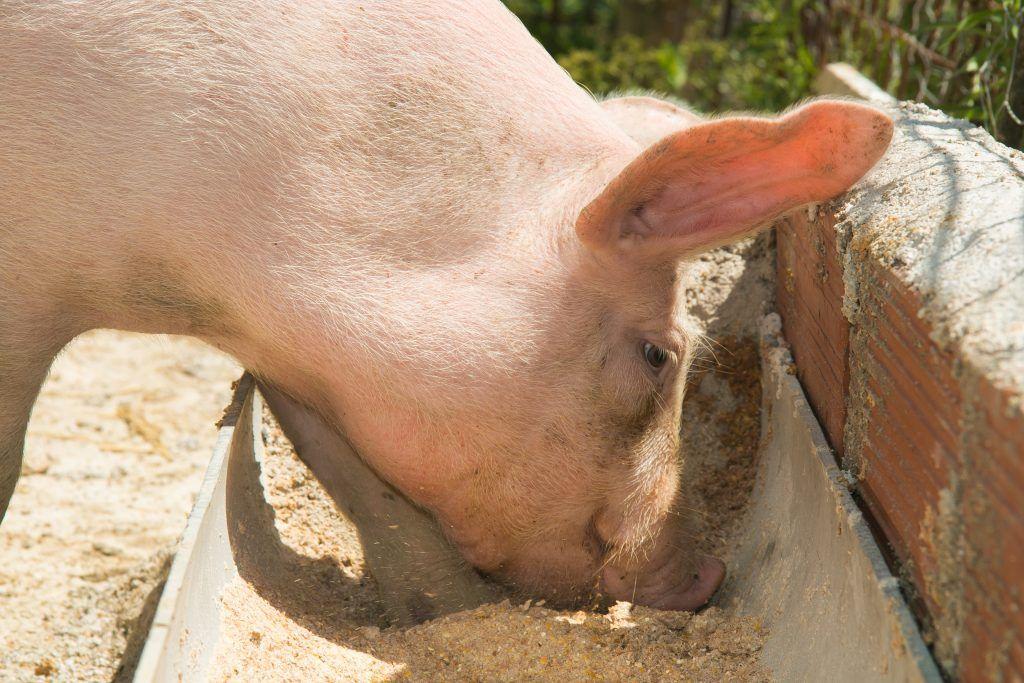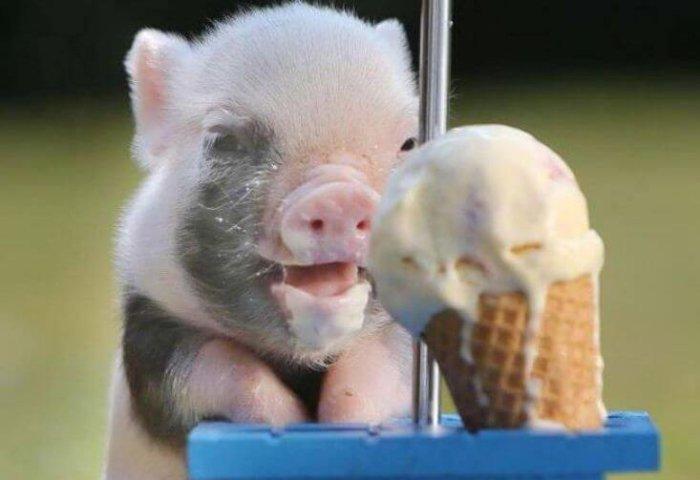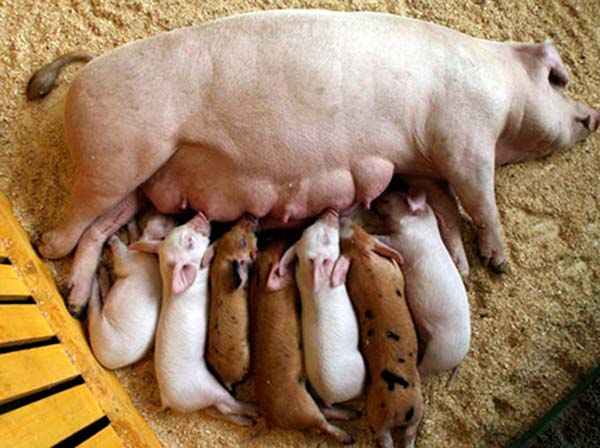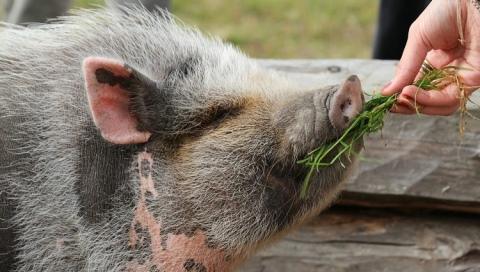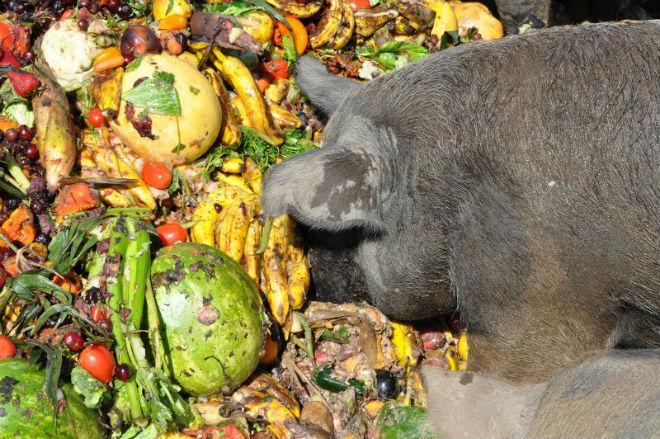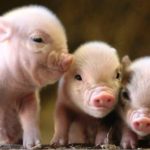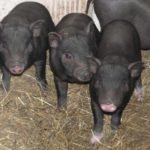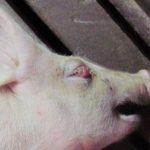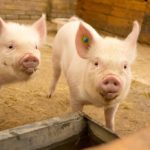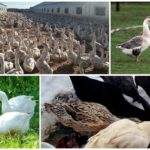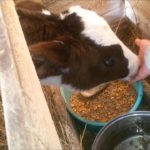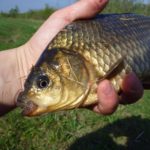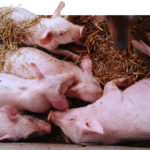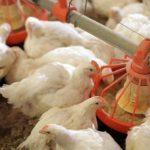Effective development of farming is possible only with proper feeding of livestock and sufficient speed of weight gain. When figuring out what to feed piglets for rapid growth at home, you need to prepare a comprehensive diet and take into account the developmental characteristics of the piglets.
Feeding periods
The diet for young animals depends on the physiological state, age and other nuances.There are situations when in the first couple of weeks the sow's milk is enough for individuals. In other situations, additional nutrients are used to ensure further development of the body.
Milk (up to 2 months)
The milk period in piglets can last up to two months. The exact duration depends on the age at which the individual was acquired. Feeding at an early age is carried out often, but in small portions. The basic food product is milk. When feeding two-month-old piglets, you must adhere to the following rules:
- In the first month, sucklings are given whole milk 5-6 times a day.
- From the 5-7th day, feed or a mixture of ground grain and boiled vegetables is additionally used. Potatoes and carrots will be useful for young animals.
- As they grow older, whole milk is replaced with skim milk, the fat content of which is in the range of 0.2-0.5%.
- When animals reach a weight of 20 kg, they are gradually transferred to the classic feeding inherent in the breed. Complex nutrition allows young animals to gain such weight in 2.5-3 months of life.
Growing up
By the time of rearing, individuals weigh 20-30 kg, and the key criterion for feeding is sufficiency. You also need to take into account that the pigs will intensively form the muscle layer, so the diet should be rich in protein elements. You can get protein from whole milk substitutes, but you need to know how to properly prepare powdered milk.
It is recommended to feed young animals three times a day during rearing. The diet is based on grain crops, nutritious grass feed and potatoes. To fill the need for protein elements, add peas, fish or bone meal. The main components of the diet are 10-35 g of salt and 5-25 g of chalk for each individual.
Fattening
At the fattening stage, differences arise in the feeding of individuals for the subsequent production of meat products or lard. The difference lies in the proportions of protein elements and carbohydrates. When fattening meat breeds, the diet is saturated with an increased amount of protein products. When fattening individuals for lard, the proportion of concentrate and potatoes is increased.
The diet should contain concentrated rather than heavy feed, since pigs have a single-chamber stomach. Food is given in a crushed state for better absorption by the body. When fattening for meat, there are several diet options. Including:
- potato concentrate - 70% concentrate, 20% beets, 5% animal feed and alfalfa meal each;
- concentrated - 90% of feed in combination with grass meal and residues from fish and meat production;
- concentrated root vegetable - the proportions of feed are similar to the first option, but instead of beets, potatoes are used.
Grain nutrition and processed oil seeds are suitable as a concentrate. They contain many useful vitamins and protein elements. The use of fish and meat waste allows you to add a number of important amino acids to the diet.
If it is necessary to raise individuals for lard, use more voluminous food. The basic diet includes 4 kg of grain feed, 4-5 kg of root vegetables, 10 kg of grass feed and 2 kg of meat production waste. In the cold season, hay flour is additionally included in the diet and the share of food waste is increased.
What to feed piglets from 1 to 6 months?
In addition to the basic feeding rules, you need to take into account the nuances of developing a diet for a specific age. This will make it possible to smoothly adjust the pigs to the chosen direction of fattening, will have a positive effect on health, and will ensure active weight gain.
One month old piglets
At the age of one month, piglets gradually adapt to a diet more familiar to adults. The digestive system also adapts, but it produces a minimal amount of hydrochloric acid, which makes resistance to viruses and bacteria weak. Feeding young animals without a sow and her milk is a stressful situation that can cause a decrease in appetite and weight loss. For the first time, dry food for weaners is supplemented with milk in a volume of up to 1.5 liters per piglet.
Whey can be used instead of milk, but the consumption rate will double.
During the development of small piglets, it is important to change the diet gradually. The dry food that the young animals received 2 weeks before weaning should be continued for a couple more weeks, after which gradual changes should begin. When it gets warmer, you can take the pigs outside and teach them to eat grass.
2-3 month old piglets
Young animals aged 2-3 months are fed 3-4 times a day. The main goal of feeding is to increase net weight by 35-50 kg over the next couple of months. Milk remains the basis of the diet, but it is often supplemented with combined and concentrated feeds. Gradually, the amount of dairy products in the diet is reduced, increasing the share of other foods. In order for piglets to actively grow and gain weight, the diet must contain:
- concentrated feed;
- chopped boiled potatoes;
- hay flour;
- juicy root vegetables.
In summer, piglets also eat grass and require at least 2.5 kg per day to grow. All components of the diet are mixed, crushed and given in small portions.
4 month old piglets and above
By 4 months, young animals adapt to almost any food, and at this moment you can switch to feeding 2-3 times a day at certain intervals.Wet mash with a thick consistency is used as the basis for complementary feeding. The mixture consists of concentrates, legumes, whey, root vegetables, salt and chalk. All components are crushed, mixed and poured with a small amount of liquid.
For convenience, you can rely on a table prepared for beginning farmers, which describes all the components of the diet. It is also recommended to provide food to the young animals outside the barn in order to raise them to the desired weight. Feeding is carried out in a specially designated area of the pen.
Growing at home
If the piglets have not gained sufficient weight, they are reared again, which is most important for breeds bred for meat production. A key requirement for growing livestock is regular drinking and adequate nutrition. Premises for rearing animals must be equipped with an automatic drinking bowl and a dry food dispensing system.
The availability of free space is also important, and the optimal indicator is considered to be at least 0.35 square meters for each individual.
What to feed for fast growth
In order for growing individuals to rapidly gain weight and not lag behind in physical development, it is necessary to provide a comprehensive and balanced diet. Accelerated growth is promoted by a combination of the following products:
- cereals;
- vegetables and juicy root vegetables - potatoes, pumpkin, beets, carrots;
- roughage - dust from legumes;
- grass feed, including a number of plants;
- dairy products and fish and meat waste.
These products have a positive effect on the taste of meat products, activate growth, and increase the graininess and density of lard.A comprehensive diet provides animals with a sufficient amount of vitamins required for the development of the body.
Prohibited foods for piglets
When planning a nutritious diet for young animals, you need to understand that a number of foods are unacceptable to feed. The health of piglets will be negatively affected by any feed containing signs of rotting, traces of mold or parasites. Despite the fact that pigs are considered to be omnivores to a certain extent, such feed worsens their body condition, especially at a young age.
Also, a number of herbs from the green food category should not be fed. Some plants contain substances that can cause serious poisoning. In particular, young animals should avoid eating black nightshade, caustic buttercup, castor oil cake, pickleweed and horse dill. You should also exclude from the diet sprouted potatoes and unripe tubers, which contain large quantities of dangerous components that are indigestible by the pig’s body.
How to understand that feeding is correct
The result of proper feeding is the active development of piglets, good health and the absence of signs of disease. To monitor the effectiveness of feeding young animals, you need to weigh them regularly and compare their weight with an indicator that is considered optimal for a particular age. This approach will also help you avoid overeating. No less important will be a visual examination of piglets, thanks to which it is often possible to notice deviations from normal development.

